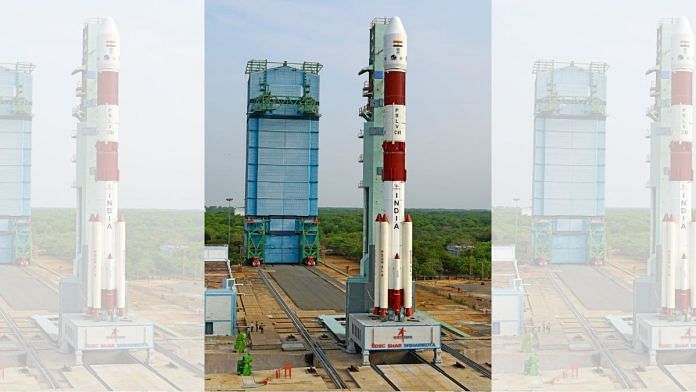New Delhi: The Indian Space Research Organisation (ISRO) is facing a challenging year in 2025. On Sunday, its Polar Satellite Launch Vehicle C-61 (PSLV-C61) mission failed after it was unable to place the EOS-9 surveillance satellites into a sun-synchronous polar orbit, the space agency said.
“Today, the 101st launch was attempted, PSLV-C61 performance was normal till the 2nd stage. Due to an observation in the 3rd stage, the mission could not be accomplished,” ISRO said in a statement.
The space agency launched EOS-09 (Earth Observation Satellite) aboard India’s trusted workhorse rocket PSLV at 5.59 am Sunday from the first launch pad at the Satish Dhawan Space Centre (SDSC) in Sriharikota.
This mission marked the 63rd flight of the PSLV and the 27th using the rocket’s XL configuration.
Earlier this year, in January, ISRO’s 100th mission—intended to place the second batch of India’s navigation satellites, NVS-02, into orbit—had failed due to a valve malfunction.
However, in a post on X Sunday, S. Somanath, former ISRO chief, said that failures were a part of ISRO’s success story, and the agency, like always, will learn and bounce back from it.
“Over the years, such challenges have only strengthened our conviction that failure is never defeat, but rather a formidable tutor. Every towering success of ISRO has been forged in the crucible of adversity—shaped by lessons deeply learnt and courageously applied,” Somanath said in a post on X Sunday.
He added, “Setbacks have ever served to refine our resolve and deepen our scientific rigour. Nothing shall deter our pursuit of knowledge, which we carry forward with characteristic poise and unwavering precision.”
ThePrint explains what went wrong with the PSLV-C61 mission and how this year has seen a series of failed outcomes.
Also read: Gaganyaan crewed mission delayed again, likely to take flight in 2027
What went wrong
The EOS-09 satellite, which was set to be carried into an SSPO (sun synchronous polar orbit), was supposed to have separated from the launcher, following which orbit change thrusters (OCT) were to be used to reduce the altitude of the spent PS4 stage to reduce its life in orbit. After this, a stage passivation exercise was to be performed by ISRO.
However, the mission failed after a fall in the chamber pressure, ISRO chairperson V Narayanan confirmed.
“Up to the second stage, the performance was normal. After the third stage, the motor started perfectly, but we observed a problem midway,” Narayanan said.
He said that there was a fall in the chamber pressure of the motor case and the mission could not be accomplished, assuring that the reasons behind the failure will be assessed in detail and the launch will be reattempted “at the earliest”.
Senior ISRO officials said to ThePrint that the space agency’s internal failure analysis committee and a government-appointed committee are likely to look into the mission failure details and submit a report in the coming weeks.
The EOS-09 was designed with the objective of providing remote sensing data for users engaged in operational applications by providing an improved frequency of observation. The spacecraft was configured using ISRO’s RISAT-1 heritage bus, with most of the functional requirements of the SAR payload and the bus platform systems derived from the earlier ISRO missions.
The mission also carried a Synthetic Aperture Radar (SAR) payload capable of providing images for various earth observation applications under all-weather conditions. It would have been crucial for providing enhanced satellite monitoring of India’s borders, while also being used for agriculture, disaster management, and infrastructure development.
Had the mission successfully placed the satellites into orbit about 500 km above the Earth’s surface, it would have enhanced India’s surveillance capabilities, which India aimed to do, especially after the recent escalated tensions with Pakistan.
A challenging 2025
On 29 January this year, the space agency’s mission to place the second batch of India’s navigation satellites, NVS-02, into orbit failed.
The NVS-02, under ISRO’s Navigation with Indian Constellation (NavIC) series, is India’s independent regional navigation satellite system designed to provide accurate position, velocity and timing (PVT) service to users in India as well as the region extending about 1500 km beyond the Indian landmass.
NavIC is designed to provide two types of services—Standard Positioning Service (SPS) and Restricted Service (RS).
“NavIC SPS provides a position accuracy of better than 20 m (2σ) and timing accuracy better than 40 ns (2σ) over the primary service area,” ISRO’s mission document said.
Its previous mission, which included the docking experiment SpaDeX, also underwent some initial glitches before it could be successfully carried out.
(Edited by Zinnia Ray Chaudhuri)
Also read: Indian astronaut Shubhanshu Shukla will fly to space with a piece of home—halwa & aam ras, from ISRO




